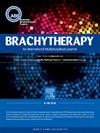The American Brachytherapy Society (ABS) consensus guidance for hybrid intracavitary interstitial brachytherapy for locally advanced cervical cancer
IF 1.7
4区 医学
Q4 ONCOLOGY
引用次数: 0
Abstract
PURPOSE
The purpose of this consensus statement from the American Brachytherapy Society (ABS) is to summarize important considerations for adding interstitial needles to intracavitary implants for cervix cancer brachytherapy.
METHODS
A panel of experts in Gynecologic Brachytherapy, including both physicians and physicists completed surveys and met virtually on multiple occasions to discuss and define current practices and approaches in order to summarize these for the ABS community. This document was drafted, reviewed and approved by the full panel and the ABS Board of Directors.
RESULTS
Hybrid brachytherapy is increasingly being utilized in cervix brachytherapy. In incorporating supplementary interstitial needles there are numerous key considerations including resources for an emergency, planning considerations, applicator selection, and pre-, intra- and postprocedural imaging. Additionally, approaches to challenging cases that would often benefit from a hybrid approach are discussed.
CONCLUSIONS
While hybrid brachytherapy offers dosimetric advantages for cervix brachytherapy, it increases procedure complexity. Being aware of the necessary resources and defining considerations can help mitigate some of the challenges and improve procedural success.
美国近距离放射治疗协会(ABS)对局部晚期宫颈癌混合腔内间质近距离放射治疗的共识指南。
目的:美国近距离放射治疗学会(ABS)的这一共识声明的目的是总结在腔内植入物中添加间质针用于宫颈癌近距离放射治疗的重要注意事项。方法:一组妇科近距离放射治疗的专家,包括医生和物理学家完成了调查,并在多个场合进行了虚拟会议,讨论和定义了当前的做法和方法,以便为ABS社区总结这些做法和方法。本文件由全体专家组和ABS董事会起草、审查和批准。结果:混合近距离放疗在宫颈近距离放疗中的应用越来越广泛。在合并补充间质针时,有许多关键的考虑因素,包括紧急情况的资源、计划考虑、涂抹器的选择以及术前、术中和术后的成像。此外,还讨论了处理具有挑战性的案例的方法,这些方法通常会从混合方法中受益。结论:虽然混合近距离治疗为宫颈近距离治疗提供了剂量学上的优势,但它增加了手术的复杂性。了解必要的资源和确定考虑因素可以帮助减轻一些挑战并提高程序上的成功。
本文章由计算机程序翻译,如有差异,请以英文原文为准。
求助全文
约1分钟内获得全文
求助全文
来源期刊

Brachytherapy
医学-核医学
CiteScore
3.40
自引率
21.10%
发文量
119
审稿时长
9.1 weeks
期刊介绍:
Brachytherapy is an international and multidisciplinary journal that publishes original peer-reviewed articles and selected reviews on the techniques and clinical applications of interstitial and intracavitary radiation in the management of cancers. Laboratory and experimental research relevant to clinical practice is also included. Related disciplines include medical physics, medical oncology, and radiation oncology and radiology. Brachytherapy publishes technical advances, original articles, reviews, and point/counterpoint on controversial issues. Original articles that address any aspect of brachytherapy are invited. Letters to the Editor-in-Chief are encouraged.
 求助内容:
求助内容: 应助结果提醒方式:
应助结果提醒方式:


